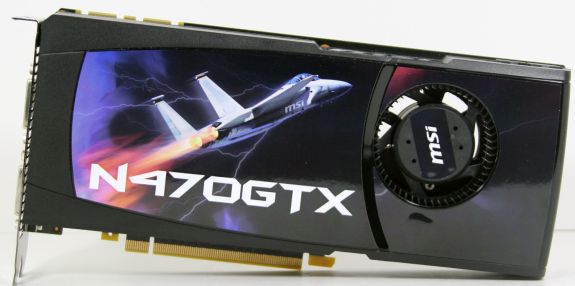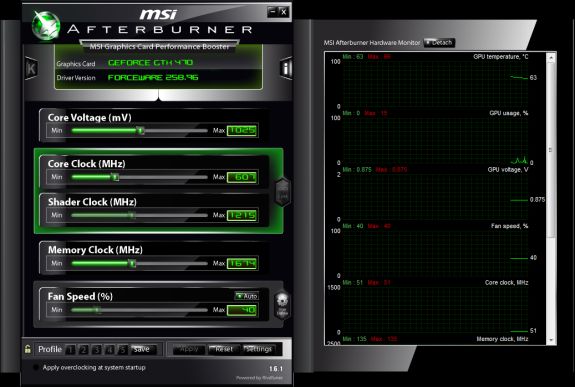MSI’s GeForce N470GTX & GTX 470 SLI
by Ryan Smith on July 30, 2010 1:28 PM ESTFor the launch of the first GF100-based video cards – the GTX 480 and GTX 470 – NVIDIA sent over a 3 card reviewer’s kit containing two GTX 480s and a single GTX 470. This allowed us to do SLI testing with the GTX 480 (a money-is-no-object setup) but not with NVIDIA’s significantly cheaper GTX 470. As part of a comprehensive SLI & CrossFire guide we’re working on for next month we needed a second GTX 470 for testing GTX 470 SLI operation, and MSI answered our call with their N470GTX.
Today we’ll be taking a look at MSI’s GTX 470. We’ll also be taking a sneak-peek of our forthcoming SLI/CF guide with a look at GTX 470 SLI performance.
| GTX 480 | GTX 470 | GTX 465 | GTX 460 1GB | GTX 285 | |
| Stream Processors | 480 | 448 | 352 | 336 | 240 |
| Texture Address / Filtering | 60/60 | 56/56 | 44/44 | 56/56 | 80 / 80 |
| ROPs | 48 | 40 | 32 | 32 | 32 |
| Core Clock | 700MHz | 607MHz | 607MHz | 675MHz | 648MHz |
| Shader Clock | 1401MHz | 1215MHz | 1215MHz | 1350MHz | 1476MHz |
| Memory Clock | 924MHz (3696MHz data rate) GDDR5 | 837MHz (3348MHz data rate) GDDR5 | 802MHz (3208MHz data rate) GDDR5 | 900MHz (3.6GHz data rate) GDDR5 | 1242MHz (2484MHz data rate) GDDR3 |
| Memory Bus Width | 384-bit | 320-bit | 256-bit | 256-bit | 512-bit |
| Frame Buffer | 1.5GB | 1.25GB | 1GB | 1GB | 1GB |
| FP64 | 1/8 FP32 | 1/8 FP32 | 1/8 FP32 | 1/12 FP32 | 1/12 FP32 |
| Transistor Count | 3B | 3B | 3B | 1.95B | 1.4B |
| Manufacturing Process | TSMC 40nm | TSMC 40nm | TSMC 40nm | TSMC 40nm | TSMC 55nm |
| Price Point | $499 | ~$300 | $249 | $229 | N/A |
MSI’s N470GTX is a reference-derived GeForce GTX 470 that’s largely – but not exactly – similar to the reference GTX 470. Clocked at the reference clocks of 607MHz core, 1215MHz shader, and 837MHz (3348MHz data rate) memory, the stock performance of the card is identical to the reference design. This also extends to cooling, where the card uses the reference GTX 470 cooler, and in terms of display capabilities with the card using the NVIDIA-standard 2xDVI + 1x HDMI configuration.
In terms of hardware, the biggest difference is the choice of component selection. MSI advertises this card of being part of their “Military Class” program, signifying that it uses solid state capacitors, chokes, and Hi-c (Tantalum) capacitors where appropriate. In practice the reference design already uses these types of components, however not in the number that MSI does. On our NVIDIA reference card there are a few locations for choke that were left open, whereas MSI has filled these locations with chokes.
With only minor differences for the hardware, the bigger differentiating feature for the N470GTX is the software. As is the case with the rest of their cards, MSI bundles the N470GTX with their dynamic duo of overclocking tools: Afterburner and Kombustor.
Afterburner is MSI’s Rivatuner-based overclocking and monitoring suite, and a wonderful tool altogether. Going beyond straightforward overclocking controls, graphing, and an OSD, the most unique feature in Afterburner is that it offers support for voltage control on most of MSI’s cards, allowing for greater overclocking potential than what can be achieved on stock voltage alone. In the case of the GTX 470, MSI even enables overvolting support on non-MSI cards by allowing overvolting to be used with any reference-alike cards using the same VRMs as the N470GTX. This is a particularly generous move on MSI’s behalf, as it would be trivial to limit this feature to just MSI cards.
Meanwhile Kombustor is MSI’s FurMark-based load testing utility. In practice it’s virtually identical to FurMark, replacing FurMark’s furry donut with a furry version of the MSI logo.
The other significant piece of software included in the package is a voucher from NVIDIA and Capcom for one of 3 Capcom games: Street Fighter IV, Resident Evil 5, or Dark Void. The voucher is in lieu of a specific pack-in title, which is an interesting take on the pack-in game concept. Pack-in games can be hit & miss depending on whether you like the game or not, so a voucher is a much more interesting way to go about things, as it lets the buyer pick from a variety of games. The downside of course is that you’ll need a broadband connection to download the game since it’s delivered purely as a downloadable title rather than having any kind of disc packed-in.

Rounding out the package is the usual collection: a driver/utility CD, a multilingual quick-start guide, 2 molex-to-6pin PCIe power adaptors, a DVI-to-VGA adaptor, and a DVI-to-HDMI adaptor. The warranty on the card is 3 years.
As of this writing, Newegg has the card listed at $299 with a $20 mail-in rebate from MSI. Depending on your feelings towards MIRs, this is either some $30 below the GTX 470 MSRP of $330 a few short weeks ago, or at $280 approaching the price of the cheapest Radeon HD 5850s. NVIDIA and MSI have done a great job of being price competitive here, and as a result the N470GTX is priced only a stone’s throw away from the 5850 while being appreciably faster and including a free game at a time when most 5850s do not.













41 Comments
View All Comments
Tunnah - Sunday, August 1, 2010 - link
seems my comments are being taken out of context, sorry guys not used to posting on a board i'm an IRC kind of guymy overshadowing comment was in reference to SLI only
was asking why study the 470 SLI at the moment when the 460 seems to be grabbing more headlines, especially with it's scaling capabilities
the 460 SLI numbers were what i was asking about, as from what i've read in other reviews the scaling is amazing and it brings it up against, and sometimes passes, the 5850 in XF
even though i know a big SLI round up is coming it just seemed weird to focus on the 470, but as they say they've been waiting for a second one to do SLI testing for a while..
mapesdhs - Saturday, July 31, 2010 - link
I see the 8800GT in the test setup summary, but why no results for it (especially SLI) in
the performance tables?
Ian.
Perisphetic - Sunday, August 1, 2010 - link
A picture of twin jet engine exhaust on the sticker & a software that's called afterburner. Can this be used for this new type of hot air drilling or just plain marshmallow roasting???Perisphetic - Sunday, August 1, 2010 - link
But jokes aside, where in the software is the setting for heat shrinking tube?nmctech - Monday, August 2, 2010 - link
I noticed a few days back they released the Quadro Fermi cards 4000, 5000 and 6000. I found a couple of gamer reviews but a more thorough review of the cards for 3D use would be nice.Have you guys had a chance to check those out yet?
mapesdhs - Wednesday, August 4, 2010 - link
I expect they'll review them eventually, but more likely reviews for the new cards
will appear on other sites first, eg. those aimed at users of Maya, ProE, CATIA, etc.
Presumably they'll run Viewperf, Cinebench, etc. among other things. I have two
Quadro FX 5500s to test (after which I'll put them up for sale), so I can gather
some results, post the data on my site for comparison to whoever reviews the
newer cards. If anyone here is interested, let me know (mapesdhs@yahoo.com)
and I'll send out a URL when the tests are done.
Btw, I was surprised to see NVIDIA's summary shows the 5500 is 3X faster than
the 5800:
http://www.nvidia.com/content/PDF/product-comparis...
so it should be interesting to see how two 5500s SLI compare to the new 6000,
sans any differences in CPU/RAM/mbd that might affected the results (my system
is a 4GHz i7 860, so the two cards will be running 8X/8X for SLI).
Ian.
hsew - Tuesday, August 3, 2010 - link
I wish SOMEBODY would do an article on multiple GPU scaling , CFX and TriSLI, on AMD vs Intel.Something like:
Core i7 980X, Core i7 9xx, Core i7 8xx, Core i5 7xx, Core i5 6xx, Core i3 5xx.
Phenom II X6, X4, X3, X2, Athlon II X4, X3, X2.
all systems 4GB ram each.
Now, I know that such an article would likely take an astronomical amount of time to write, BUT, it would answer a seriously nagging question:
Do you really need four or more cores in a Multi-GPU system? Do you even need an Intel CPU to effectively run a Multi-GPU system?
Exelius - Wednesday, August 4, 2010 - link
I think the reason this hardware is so boring is that the difference between low-end cards and high-end cards is so high. Low end cards are far more popular though; and game companies aim for the lowest common denominator. Thus there is no market for exciting cards because there are no games that can use them.NVidia knows this; and are desperately trying to find a new market for their hardware. ATI knew this, which is why the merger with AMD happened. I'm guessing NVidia won't last long as an independent company; Fermi for HPC isn't catching on quickly and I don't think NVidia is in a stable enough position to convince HPC users to begin the costly and time consuming project of moving to Fermi. I think they need an Intel, IBM or HP behind them for that to happen.
But yes, PC graphics have become boring. Blame $400 PCs and smartphonea for that.
Heatlesssun - Saturday, August 7, 2010 - link
Haven't played with a high-end system lately have you? Graphics boring on high-end PCs, you gotta be kidding me! 3D Surround, just amazing stuff that that $400 PC and smart phone need not apply.Patrick Wolf - Monday, August 16, 2010 - link
It'd be great if you explained under what conditions you record temps. Things like using a case or an open bench? Are there any additional fans blowing on the card(s)? Room temp? How long do you run Furmark and what settings are used?